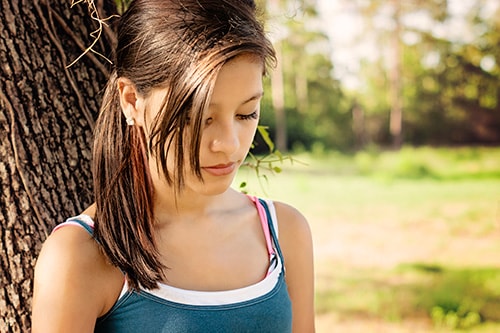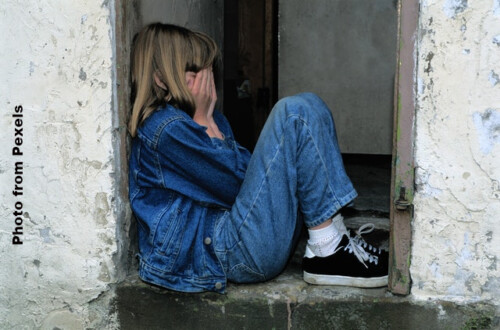Anxiety and Depression in Children
Find information and resources for parents on how to help children cope

Many children have fears and worries, and may feel sad and hopeless from time to time. Strong fears may appear at different times during development. For example, toddlers are often very distressed about being away from their parents, even if they are safe and cared for. Although fears and worries are typical in children, persistent or extreme forms of fear and sadness could be due to anxiety or depression. Because the symptoms primarily involve thoughts and feelings, they are sometimes called internalizing disorders.
Anxiety
When a child does not outgrow the fears and worries that are typical in young children, or when there are so many fears and worries that they interfere with school, home, or play activities, the child may be diagnosed with an anxiety disorder. Examples of different types of anxiety disorders include
- Being very afraid when away from parents (separation anxiety)
- Having extreme fear about a specific thing or situation, such as dogs, insects, or going to the doctor (phobias)
- Being very afraid of school and other places where there are people (social anxiety)
- Being very worried about the future and about bad things happening (general anxiety)
- Having repeated episodes of sudden, unexpected, intense fear that come with symptoms like heart pounding, having trouble breathing, or feeling dizzy, shaky, or sweaty (panic disorder)
Anxiety may present as fear or worry, but can also make children irritable and angry. Anxiety symptoms can also include trouble sleeping, as well as physical symptoms like fatigue, headaches, or stomachaches. Some anxious children keep their worries to themselves and, thus, the symptoms can be missed.
Depression
Occasionally being sad or feeling hopeless is a part of every child’s life. However, some children feel sad or uninterested in things that they used to enjoy, or feel helpless or hopeless in situations they are able to change. When children feel persistent sadness and hopelessness, they may be diagnosed with depression.
US Preventive Services Task Force: Learn about recommendations to screen children and adolescents for depressionexternal
Examples of behaviors often seen in children with depression include
- Feeling sad, hopeless, or irritable a lot of the time
- Not wanting to do or enjoy doing fun things
- Showing changes in eating patterns – eating a lot more or a lot less than usual
- Showing changes in sleep patterns – sleeping a lot more or a lot less than normal
- Showing changes in energy – being tired and sluggish or tense and restless a lot of the time
- Having a hard time paying attention
- Feeling worthless, useless, or guilty
- Showing self-injury and self-destructive behavior
Extreme depression can lead a child to think about suicide or plan for suicide. For youth ages 10-24 years, suicide is among the leading causes of death. Read about youth suicide prevention.external icon
Some children may not talk about their helpless and hopeless thoughts, and may not appear sad. Depression might also cause a child to make trouble or act unmotivated, causing others not to notice that the child is depressed or to incorrectly label the child as a trouble-maker or lazy.
Treatment for anxiety and depression
The first step to treatment is to talk with a healthcare provider such as your child’s primary care provider, or a mental health specialist, about getting an evaluation. The American Academy of Child and Adolescent Psychiatry (AACAP) recommends that healthcare providers routinely screen children for behavioral and mental health concerns. pdf icon[217 KB, 13 pages]external icon Some of the signs and symptoms of anxiety or depression in children could be caused by other conditions, such as trauma. Specific symptoms like having a hard time focusing could be a sign of attention-deficit/hyperactivity disorder (ADHD). It is important to get a careful evaluation to get the best diagnosis and treatment. Consultation with a health provider can help determine if medication should be part of the treatment. A mental health professional can develop a therapy plan that works best for the child and family. Behavior therapy includes child therapy, family therapy, or a combination of both. The school can also be included in the treatment plan. For very young children, involving parents in treatment is key. Cognitive-behavioral therapy is one form of therapy that is used to treat anxiety or depression, particularly in older children. It helps the child change negative thoughts into more positive, effective ways of thinking, leading to more effective behavior. Behavior therapy for anxiety may involve helping children cope with and manage anxiety symptoms while gradually exposing them to their fears so as to help them learn that bad things do not occur.
Treatments can also include a variety of ways to help the child feel less stressed and be healthier like nutritious food, physical activity, sufficient sleep, predictable routines, and social support.
Get help finding treatment
Here are tools to find a healthcare provider familiar with treatment options:
- Psychologist Locatorexternal icon, a service of the American Psychological Association (APA) Practice Organization.
- Child and Adolescent Psychiatrist Finderexternal icon, a research tool by the American Academy of Child and Adolescent Psychiatry (AACAP).
- Find a Cognitive Behavioral Therapistexternal icon, a search tool by the Association for Behavioral and Cognitive Therapies.
- If you need help finding treatment facilities, visit MentalHealth.govexternal icon.
Managing Symptoms: Staying Healthy
Being healthy is important for all children and can be especially important for children with depression or anxiety. In addition to getting the right treatment, leading a healthy lifestyle can play a role in managing symptoms of depression or anxiety. Here are some healthy behaviors that may help:
- Having a healthy eating plan centered on fruits, vegetables, whole grains, legumes (for example, beans, peas, and lentils), lean protein sources, and nuts and seeds
- Participating in physical activity for at least 60 minutes each day
- Getting the recommended amount of sleep each night based on age
- Practicing mindfulness or relaxation techniques
Prevention of anxiety and depression
It is not known exactly why some children develop anxiety or depression. Many factors may play a role, including biology and temperament. But it is also known that some children are more likely to develop anxiety or depression when they experience trauma or stress, when they are maltreated, when they are bullied or rejected by other children, or when their own parents have anxiety or depression.
Although these factors appear to increase the risk for anxiety or depression, there are ways to decrease the chance that children experience them. Learn about public health approaches to prevent these risks:
Source: Centers for Disease Control

